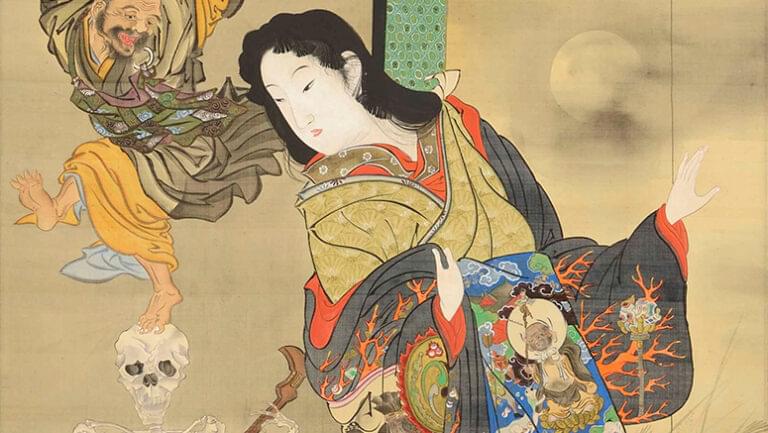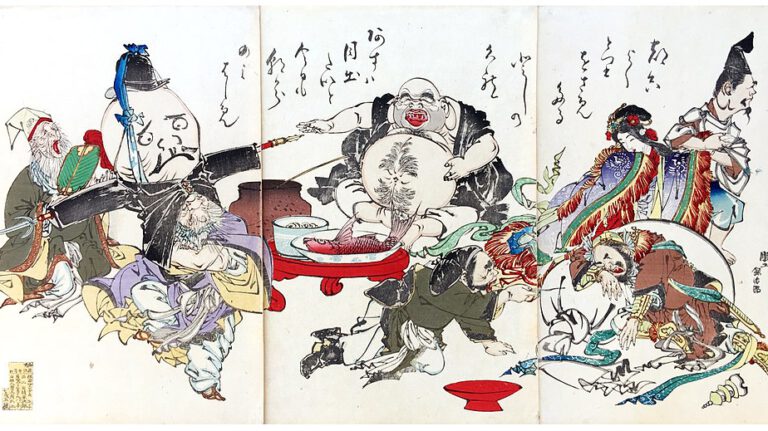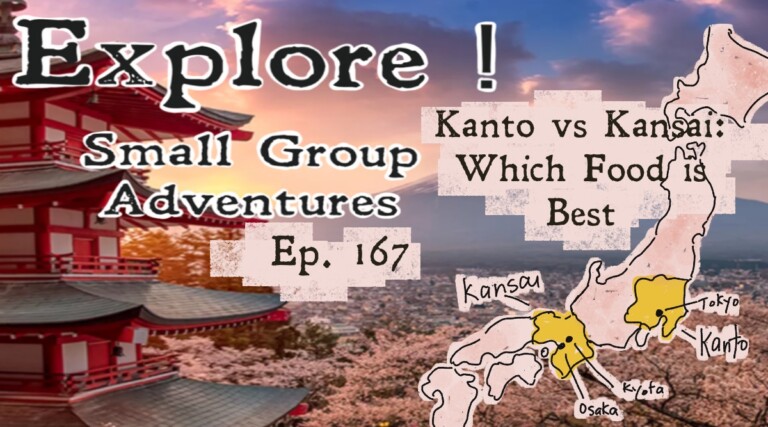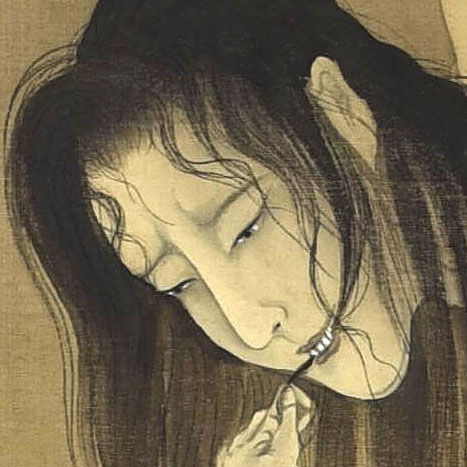This is Thersa Matsuura and you’re listening to Uncanny Japan.
Let’s pretend you want to become a samurai or a ninja, for that matter. Or maybe an acupuncturist or an herbalist. Maybe you want to become a master of fusui (fengshui) or even the tea ceremony or really dig into esoteric Buddhism. Well, whichever path you choose, there’s a lot you need to study and decades of training you need to do, and you’ll probably have to learn a little Japanese along the way; but if it is your dream, I think I can help with one thing. Let me tell you about a concept that you’ll need to be familiar with. The Five Elements.
Some questions you might be asking yourself right now: What are these five elements you speak of? What do they do? And if I personally were one of them, which one would I be?
Stay right there, I’ll get to all of that in just one second.
Intro
Free Story for Preorders
Hey hey, how are you? A quick mention of my upcoming book: The Book of Japanese Folklore: An Encyclopedia of the Spirits, Monsters, and Yokai of Japanese Myth and a reminder that if you’ve preordered it, email me at thebookofjapanesefolklore@gmail.com with a screenshot of that or the name of the bookstore you ordered it from and I’ll send you a recording of my retelling of “The Wife Who Didn’t Eat”, called “Kuwazu Nyobo” in Japanese. Speaking of The Book of Japanese Folklore, it’s been decided by the powers that be that I’m also going to read it for the audio version — which I’m doing now, actually —, so a preordered audio book, too, gets you the hour long creepy folktale. thebookofjapanesefolklore (all spelled out) at gmail.com.
What Are the Five Elements?
Okay, on to elements. Pop quiz. What are the five elements? Are they earth, water, fire, metal (or gold), and wood? Or are they: Earth, water, fire, air (or wind) and void? The answer: Why not both? Yes, both.
The Gogyo and the Godai
First, let’s try and make this not so confusing. There are actually two different groupings of Five Elements and they are a little bit different. There’s the Gogyo and the Godai. Gogyo is written with the character Five and the kanji for to go/iku. I see it translated into English as Five Phases or Five Agents. And then again, elsewhere, as Five Moving States. The thought here is, the five moving things are the planets — Jupiter, Saturn, Mercury, Mars, and Venus (because each one is connected to one of the elements) and they move (as do the elements — more on that in a sec). Meanwhile, Godai reads: Five Big. A little simpler. As always there is overlap and all that, but here are the basics.
The Gogyo
Let’s start with the gogyo because it reached Japan first, having come from China somewhere between the 5th and the 7th centuries. Originally from Daoism, these five elements are — earth, water, fire, metal (sometimes translated as gold), and wood. In Chinese together they are called the “five elements theory” or Wu Xing in Chinese. This is a philosophy that believes in the relationship and interdependence between all things. One element isn’t better or stronger than any of the others. Everything is equal. But there’s a creation order and a destruction order which you’ll see represented by a pentagram, one of the elements on each of the points. Arrows are usually drawn to designate what destroys what, what creates what. There are all kinds of relationships between the five elements. A pentagram, by the way, is called a gobousei in Japanese.
The Pentagram and Onmyodo
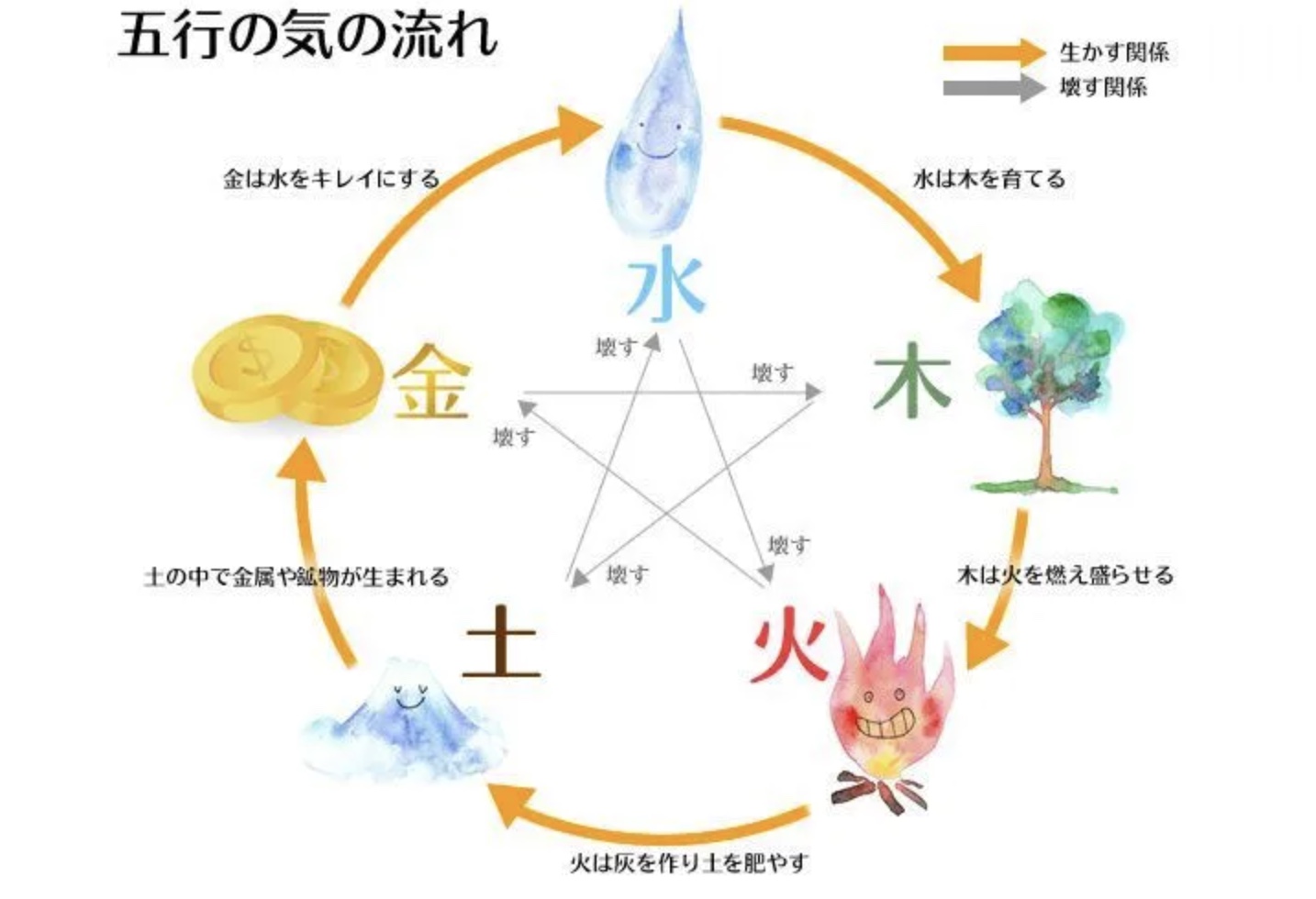
Now that we’re talking about pentagrams, have you ever heard of Abe no Seimei? I’m going to do an episode on him soon, but for now just know that he was an incredibly powerful onmyoji who practiced onmyodo. Think, high magic and divination — although that’s a very simplified definition. Anyway, for the study and practice of onmyodo the gogyo was very important. You’ll see the pentagram as a symbol of both Abe no Seimei and the practice of onmyodo, sometimes called the Way of Yin and Yang. Some say Abe no Seimei invented the pentagram independently here in Japan, others say he borrowed it from Tantric or esoteric Buddhism or Daoism. However it happened, it was used and is still used as a lucky charm or talisman. You’ll find the pentagram all around the Seimei Shrine in Kyoto where you can buy your own ofuda with one on it.
Gogyo Used Elsewhere
Gogyo is also used in the practice of Kampo also called Kampo Yaku (herbal medicines), acupunture, and fusui (feng shui) — the knowledge and art of placing things or building things in certain areas to facilitate the flow of chi energy and bring about harmony and good luck. All of these ancient traditions — still around today, by the way — are based on the theory of the five elements, gogyo.
The Godai
So what’s this second Godai then? Well, this second five element cosmology also came to Japan from China. But where Gogyo feels very Doaist, Godai’s roots are mixed in esoteric Buddhism (though not of Tibetan origins, but from Indian texts). It then moved through China and eventually reached Japan. A monk named Kukai was studying this mystical Buddhism in China in the early 800s and ended up brining it back to Japan and calling it Shingon. The Godai was very likely part of the teachings he received and he taught it later even adding a sixth element “consciousness” that unites all the others; but we won’t get into that. Let’s stick with five.
Which Elements are Different?
First, of these five Godai elements the first three are the same as the gogyo: earth called chi, water/sui, and fire/ka; then instead of metal and wood, there are wind or air called fu and space, void, or sky called ku, also translated as emptiness and no self. Godai.
Where the gogyo are all interconnected, often seen on a pentagram and also related to yin yang which is moving — Wood feeds fire, fire makes earth (think the ash from a burned tree), earth bears metal (think metals mined from the earth) etc. — Godai don’t have that entanglement so to speak. It’s a static philosophy with the first four (earth, water, fire, wind) being building blocks of all states physical, mental, emotional, and spiritual. Ku or void or sky represents everything that is beyond our comprehension, but also creation itself.
Martial Arts and the Five Elements
Some martial arts think of the Godai (also called go rin or five rings) something like: Earth symbolizing natural power, water means fluidity and change. Fire is passion. Wind freedom and growth. And ku is the no self, or perfect peace. I’m sure all the martial artists out there know about the Book of Five Rings written by the great samurai Miyamoto Musashi in 1645. Those five rings are the five elements of course.
You’ll find both versions of the five elements all over martial arts. In kendo there is the gogyo no kata. Or Gogyo form. The five elements are extremely important in ninjutsu, but also in aikido and all sorts of kung fu styles.
Godai and Graveyards
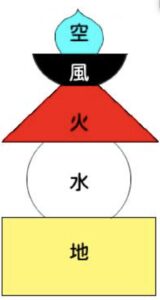
Here’s another place you might have run into the five elements, specifically the Godai. Have you ever been to a Buddhist temple or graveyard and seen a small five-tiered stone pagoda consisting of different shapes all stacked up? That’s called a gorintou, or five-ringed tower. The five different shapes represent each of the elements in order. The very bottom is a cube for earth, on top of that a sphere for water, next up is a pyramid for fire, then a crescent-looking shape for air or wind, and on the very top a somewhat peach or jewel-looking shape indicating the void. The top two tiers in Japan resemble a lotus blossom sometimes, too.
Also in Japanese cemeteries you’ll find long thin pieces of wood with fancy writing on them. These are called Sotoba and have the special new name of the deceased person written on them, as well as other things like prayers. Even though they are long thin strips, the outline of their shape has been cut to represent the same shapes as the gorinto I just mentioned. Godai in the wild again.
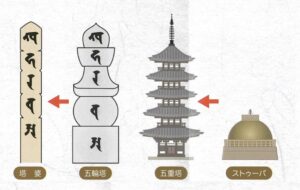
And finally I talked about Buddhism and Daoism a lot but Shinto has also been influenced by the five elements. Which makes sense when you remember that way back in the day, it was okay to practice Shinto and Buddhism side by side, so you’ll find neat fusion of practices if you look closely.
What Element Are You?
And now for the moment you’ve all been waiting for. The answer to that question that keeps you up at night: If I were an element? What element would I be?
Just to review, so on Uncanny Japan, I’ve talked about which animal zodiac sign are you (episode 67), and which lucky god are you (episode 116), and which Buddhist icon are you (episode 107), but since it’s the beginning of the year and it’s always fun to know yourself a little better, lets find out what element you are. And these will be the gogyo or wu xing, so no metal or void.
Earth People
If the year of your birth ends in 8 or 9 — 1978 or 1979, or 1988 or 1989, you get the picture, you are earth. Wow. You’re enormous. Floating in the vastness of space, you are home. You contain everything we puny humans need to exist. We depend entirely on you. So it’s no wonder earth people are thoughtful, deep thinking, and peace loving. The immensity of your spirit allows you to remain calm in adverse situations. You’re dependable. You also enjoy helping others. It’s just in your earthy nature. You would, though, appreciate a little notice and gratitude for your wonderfulness though. A little respect even. You don’t like to be taken advantage of.
Fire People
If your birth year ends in 6 or 7, you are fire. You might imagine your self as a majestic bonfire at night on a vast shore. There dancing wild with untamed energy. A primal beauty you are, captivating and intense. It’s no surprise that fire people have bold spirits and adventurous natures. Once you become excited about something you’re highly motivated and very passionate about whatever it is. Nothing can stand in your way. You just kind of blaze on through. You like to have fun, but but you also like others to have fun, too. You’re spontaneous and hardworking, but be careful because you get bored of things and people easily.
Water People
Next, if your birth year end in 2 or 3, you are water. Imagine you’re the enormous ocean, stretching from horizon to horizon. On top you’re all rippling waves and splashes. But underneath you’re incredibly deep and full of mysteries and weird fish. It’s only natural then that water types are complex introverts who like to be alone. You’re perceptive and cerebral and value the time you have to just quietly contemplate and ponder and create. A nice rainy day snuggled up on the couch reading all by yourself and reflecting on life sounds perfect to you. Be careful not to isolate too much, though, lest you become a little passive and selfish.
Metal People
If the year you were born ends in 0 or 1 then you are metal. Think of all the multitudes of metals found deep inside the earth. Iron, copper, gold, silver, lead, titanium to name a few. All these embody varying degrees of strength and resilience. Sleek or rugged, you’re hard and cool to the touch. But not in a bad way. Metal types are organized and disciplined, and can accomplish whatever needs to be done. You’re also modest, economical, and don’t need to collect a lot of stuff around you. Metal personalities are faithful friends as well. However, you might have a problem letting something go though, and I’m not physical items but pity the fool who is disloyal to you or betrays your trust.
Wood People
If the year you were born ends in 4 or 5, you are wood. Imagine a great old growth tree in a forest. Centuries old. This is you. You’re patient, understanding, wise, and compassionate. Since you are part of a forest with your deep roots all interconnected with your other tree friends and tree family, this shows that you are very good at communicating, you’re sociable, and quite frankly you are very interested in growing and expanding as a person. Some might call you a visionary. Be careful not to get too obsessed with your own forward progress, though, you don’t want to disrespect or overshadow those around you.
And there we go for the two groups of five elements. If you want to learn more there’s a great website called “Elemental Japan” by author, scholar, and frequent Japan resident, Jann Williams. I found her site extremely informative.
New Website and Merch Shop
I’d like to mention my refurbished website. The Man Who Can Do All Things, Richard, just gave my personal (Thersa Matsuura) site a swanky revamping. I’m still working on some of the pages, so that’s on me, not him. But there is a link there for those who preordered The Book of Japanese Folklore to get the audio story, “The Wife Who Didn’t Eat” as well as links to our shop where you can buy awesome Uncanny Japan goodies (shirts, stickers, magnets, mugs, notebooks, yoga mats, you name it). Not only the Uncanny Japan awesome logo that was made by Travis Pixels, go check him out—incredible artist, but also I’m starting to put some of the weirdo postcard designs I do for patrons up there, too.
And please consider becoming a patron. The podcast is free to listen to, but not free to make. For as little as 5 dollars a month there’s already over a 100 Bedtime Stories — folktales and stories for patrons only that I’ve translated and read — as well as loads of binaural sounds, recipes, and weekly blog posts about all manner of thing: Neat language stuff I discover, odd fads going on, and my perplexing relationship with my crow hating neighbor. Thank you, Patrons. I love you all.
I’ll talk to you again in two weeks. Bye Bye.

